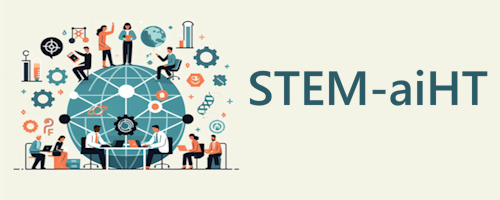Mission
Our mission is to leverage the power of STEM, Human Technology, and Artificial Intelligence to create innovative solutions that enhance human capabilities and foster technological advancement. With a foundation built on extensive experience in software development, human technology, and AI, we aim to bridge the gap between technology and humanity, ensuring the efficient use of resources and empowering individuals to achieve more. Through disciplined approaches and thoughtful integration of AI, we strive to reduce mundane tasks, facilitate creative thinking, and provide tools that support personal growth and organizational success. Our goal is to navigate the complexities of the modern world with responsible, cutting-edge technology and to inspire innovative approaches to solving significant problems.
Foundation
The content on this website is built upon my extensive education, experience, and research in three intersecting disciplines: STEM, Human Technology, and Artificial Intelligence.
First, my background in computer application development, software architecture, and full-stack engineering. I have held various positions, from application programmer to Chief Software Architect. This experience spans several knowledge domains, including medical laboratory testing, human services patient demographic and contractual management, telecommunications infrastructure deployment and sustainment, aerospace quality inspection and warehouse management systems, insurance property and casualty online quoting systems, online construction document management, and volunteer management systems.
Second, my expertise in human technology. This critical component ensured the success of the projects I undertook. Human technology encompasses all skills and processes necessary for the efficient use of people and technological resources, facilitating the matching of the best people with the best tools and processes.
Third, my knowledge of Artificial Intelligence. AI is undeniably a game-changing technology, but here we take a disciplined approach to what AI is and is not. AI has empowered people with access to a wealth of information collected from numerous systems. While much has been made of its successes and failures, we will first examine AI in the form of ChatGPT as a tool to organize our thinking and collaborative processes. Our goal is to create and use AI models to reduce mundane work.
Recommended Reading List
The recommended reading list includes works that reflect key areas of my interest:
- STEM
- Artificial Intelligence
- Personal growth strategies for enhanced thinking and innovation
- Interpersonal and organizational dynamics and the skills necessary to master them
- International relations, its history, and likely future developments
- Emerging trends in technology, politics, and economics, and the challenges they may present
- Values needed to use new technologies responsibly
Taking time to engage with this material will provide a well-rounded background to navigate a world of rapidly expanding information. It also offers insights into communicating within an increasingly diverse landscape of thinking and technological approaches to solving significant problems.
Analysis
I reflect on my days as an undergraduate in the 1970s, combing through musty library stacks, reading old journals, handwriting notes, ensuring correct references, and typing on a manual typewriter to submit assignments. Fast forward to today’s undergraduates, who surf the internet at their convenience, cut and paste passages from online documents, and use their laptops and iPads to quickly produce documents to email to their professors. Now, with the addition of AI, the debate rages on college campuses, but that’s a topic for another blog.
As complexity increases exponentially, we need new ways of thinking and new tools to help organize and suggest approaches. This is where AI, like ChatGPT, comes in.
Consider the evolution of information itself. From the beginning of tribal knowledge handed down by oral tradition, to writing on clay tablets and papyrus, which began to collect information in a more durable form. Handwritten books were less fragile and more portable, helping to spread information. The invention of the printing press, and later movable type, significantly expanded the amount of information that could be collected and disseminated.
The spread of raw information began to overwhelm civilization; libraries grew, and cataloging systems were devised. Books and periodicals were put on microfiche. However, it was becoming difficult and time-prohibitive to find specific items or all related items. The internet was born, and companies like Yahoo, Google, and others began collecting, indexing, and, most importantly, creating search mechanisms and algorithms.
Now, we have Artificial Intelligence to assist us. While many AI engines face challenges, such as generating unsubstantiated or unsupportable conclusions, it is essential to refine and improve these tools, as with all new technologies.
Comparing Human Thinking and AI
Currently, the key difference between human inquisitiveness and AI is our ability to gather new data by interacting with our environment. Current AI requires humans to feed data into the system or give it access to some data source. Humans, on the other hand, can explore and manipulate their environment, freely starting down a path and then becoming distracted by something unique and unusual.
In Think Like a Rocket Scientist and Awaken Your Genius, Ozan Varol emphasizes the importance of not forcing our thinking but allowing our minds to relax and wander. This approach helps us process the myriad inputs we gather daily, increasing our chances of reassembling data into innovative solutions. He rightly observes that people do not spend enough time engaging in “Thought Experiments”—those spontaneous, free-form daydreams that can lead to creative insights. This sets us apart from AI.
Call to Action
We invite collaborators, content providers, business and educational organizations, and all those interested in the intersection of AI and human technology to join us in this mission. Whether you are passionate about contributing your expertise, eager to share innovative ideas, or looking to implement practical solutions that align with our goals, we want to hear from you. Let’s work together to harness the potential of AI and human technology, driving forward a future where creativity, efficiency, and personal growth are at the forefront. Connect with us to explore opportunities for collaboration and to be part of a movement dedicated to transforming how we interact with technology for a better tomorrow.
